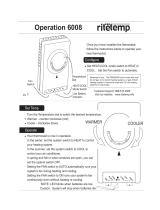
Product Description
• Available in straight cooling (PTAC) or heat pump
systems (PTHP).
• Heat pumps (PTHP) reduce energy costs and operate
in mechanical heat mode down to outdoor temperature
of 40°F (4.4°C). Below 40°F (4.4°C) heating is
accomplished by an auxiliary heat option.
• Use R-410A refrigerant.
• Include high-efciency rotary compressors, protected
by a 5-year warranty.
• Include enhanced high-efciency heat exchangers.
• Offer two fan speeds.
• Incorporate positive condensate re-evaporation to
improve efciency.
• Have optional motorized fresh-air feature with positive
pressure seal.
• PTAC/PTHP units are available in nominal sizes of
9,000 Btuh, (2.6kW) 12,000 Btuh (3.5kW) or
15,000 Btuh (4.4kW).
• PTAC units (straight cooling only) are also available at
18,000 Btuh (5.3kW).
• Energy Efciency Rating (EER) as high as 9.
• Coefcient of performance (COP) ratings as high as
2.70 for heat pumps.
Standard Controls And Components
– Construction
• 20-gauge galvanized steel construction of chassis.
• Condenser bafe options to accommodate extended
wall sleeve applications.
• Powder-coated condenser and evaporator drain pan.
• Foam strip seal for supply air duct.
• Weather strip insulation.
– Air Systems
• Thermally-protected PSC type motors.
• Air-stream surfaces insulated with 1/4" ber-glass or
1/8" (3.2 mm) Volara™.
• Forward-curved type indoor fan, directly mounted to
motor shaft.
• Unit mount controls include eld selection switch
to control indoor fan by cycling with compressor
operation or continuously with the unit.
– Condensate Removal
• Outdoor fan incorporates condensate slinger ring.
Condensate is thrown onto coil, where it evaporates,
improving system performance.
• Thermostatic drain pan valve for condensate
elimination when outdoor temperature drops below
60°F (15°C), heat pump units only.
– Controls
• Unit-mounted operating controls include thermostat,
fan speed control, heat/cool switch, fan cycle switch,
fresh air switch, if equipped.
• Ability to utilize 1-stage or 2-stage thermostat. 2
stage thermostat is capable of activating emergency
heat if auxiliary heat source is available.
• Low ambient protection — see "Microprocessor
control board" for details.
• Ability to control normally-open or normally-closed
motor valve switch, available on hydronic heat units
only. Order valve controls for 24V or line voltage.
• All hydronic heat units include molex plugs for
connection of hydronic valve motor.
• Remote mount controls include fan speed control and
fresh air switch, if equipped.
• All units are equipped with manual reset high
pressure switch which prevents abnormal high
pressure operation, increasing compressor reliability.
– Microprocessor Control Board
• Universal control board is used in straight cooling,
electric resistance heat, hydronic heat, or cooling/
heat pump applications.
• Random start timer prevents multiple units from
simultaneous startups after power interruption or on
initial power-up.
• Fan purge — fan remains on for 60 seconds after
heat/cool is satised.
• Anti-short-cycle compressor protection prevents the
compressor from rapid cycling, increases compressor
reliability.
• Freeze-protection prevents evaporator coil freeze up,
improving compressor reliability.
• Low ambient lockout prevents compressor operation
in outdoor temperatures less than 40°F (4.4°C).
PTHP units supplied with unit-mounted control,
Control causes automatic changeover to auxiliary
heat, if installed.
• Test operation — all timers are temporarily
suppressed to allow ease of testing or
troubleshooting.
• Control board LED provides self-diagnostic
troubleshooting codes, see "Sequence of operation."
Field-Installed Accessories
• Hydronic heat — coil assembly is shipped loose for
eld installation.
• Remote wall thermostat — digital 1-stage or 2-stage
available.
• Wall sleeves, louvers, and cabinets
• Aquastat - delays fan start-up until coil reaches
100°F (38°C) to eliminate "cold" blow condition.
• Hydronic control valve , Water 2 way & 3 way
• Hydronic control valve, Steam 2 way
• Hydronic Isolation valve, 1/2 in Sweat Connection.
GENERAL PRODUCT INFORMATION
7 Made in USA
P/N 240010545, Rev. B [10/24/2014]






















